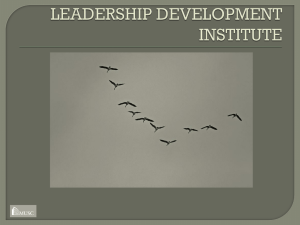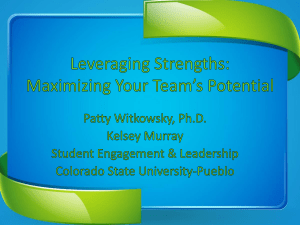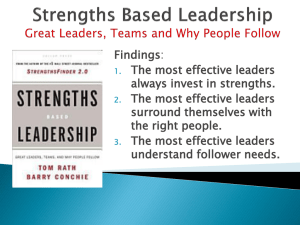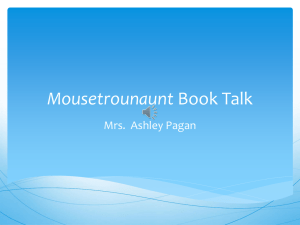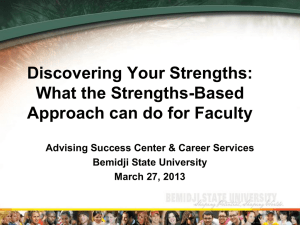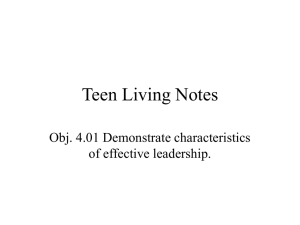WorkStrides: A Strengths-Based Approach to Career Development
advertisement
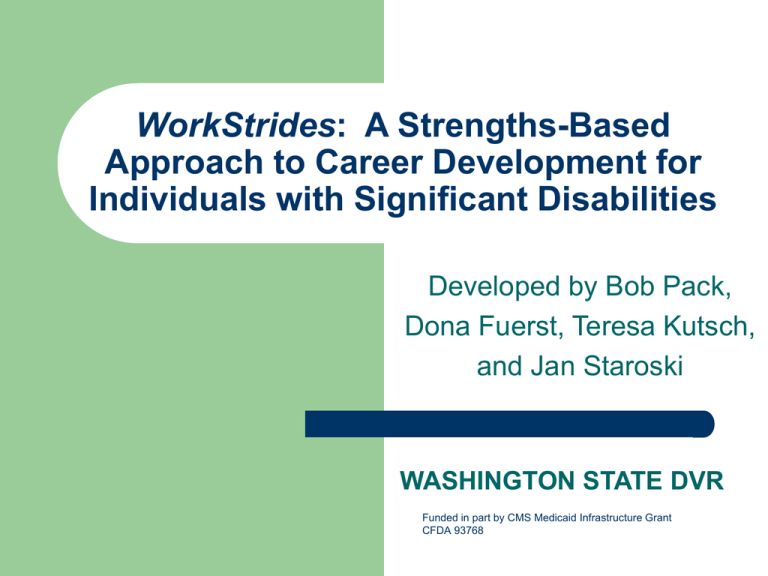
WorkStrides: A Strengths-Based Approach to Career Development for Individuals with Significant Disabilities Developed by Bob Pack, Dona Fuerst, Teresa Kutsch, and Jan Staroski WASHINGTON STATE DVR Funded in part by CMS Medicaid Infrastructure Grant CFDA 93768 What is it? 12 four-hour sessions over three weeks “Economy of Effort” Assisting customers to move through the VR process in a more timely and effective manner Providing tools to empower customers to make solid, fact-based decisions regarding their rehabilitation program Some Wisdom That Guides Us Whether you think you can, or think you can’t, you are right. - Henry Ford Success is a journey, not a destination. - Ben Sweetland Your work is to discover your work and then with all your heart to give yourself to it. - Buddha Success is not the key to happiness. Happiness is the key to success. If you love what you are doing, you will be successful. - Albert Schweitzer What is WorkStrides? Increasing customer confidence and selfadvocacy through experiences Moving the focus of attention from “problems” to “solutions”, and from “disability” to “capability” Developing short-term and long-term goals Inspiring customers to their own power and beauty Turning the hard stuff into fun stuff! Employment Readiness Scale Used in WorkStrides as a Pre-test / Post-test Web-based self-assessment instrument www.employmentreadiness.com 45 items rated on a 5-point scale, and 30 items that are True / False Field tested at over 50 sites in Canada and U.S. Used with PWD (Persons with Disabilities) and Indigenous peoples of Canada Employment Readiness Scale Operational definition of employment readiness: “Being able, with little or no outside help, to find, acquire, and keep an appropriate job, as well as to be able to manage transitions to new jobs as needed.” Employment Readiness Scale ERS examines three goals related to becoming employment-ready: 1. Self-sufficiency in five dimensions of employability, including: career decision making skills enhancement job search job maintenance on-going career mgmt Employment Readiness Scale 2. Goal #2: Understanding the particular challenges one faces, including personal, environmental, systemic, and total 2. #3: Supports available to effectively cope with the challenges, including: Self efficacy Outcome expectancy Social Supports Work History Employment Readiness Scale Levels of Readiness: – – – NOT READY; less than a 40% chance of becoming successfully employed, with a high likelihood of not retaining employment MINIMALLY READY, a 60% chance of becoming successfully employed in 12 weeks, with a high likelihood of not retaining employment READY, an 80% chance of becoming successfully employed in 12 weeks and high likelihood of remaining employed Employment Readiness Scale Examples of questions: – I am good at solving problems – I do well in job interviews 1 = strongly disagree 5 = strongly agree – I have moved at least twice in the last six months True or False WorkStrides Curriculum Session 1 Who Am I? – Getting the most out of my DVR experience – Clarification of the role of the VRC – Balance Wheel exercise – Reveal Your Strengths – Brainstorming exercise Reveal Your Strengths (examples) One of the things I do best is … An event in my life in which I showed great strength was … Ever since I was a child, I have been able to: If I were to receive an award, it would be for: I’ve always had a knack for … Brainstorming Increases flexibility of thinking – 3 things I have learned – 3 things I like to do in my spare time – 3 things I like to talk about – 3 subjects I enjoyed in school – 3 things I could show someone else how to do WorkStrides Curriculum Session 2 WHO AM I? (Continued …) – Introduction of Teaching stories • Story listeners are more receptive learners, accessing different parts of the brain, goes back to our oral traditions – Life mapping exercise • Identification of the hills and valleys of our lives • Were all the good things that happened really good? (and vice versa) WorkStrides Curriculum Sessions 3 -7 Dependable Strengths – Developed by Dr. Bernard Haldane, the “grandfather” of career counseling in the USA – Created in 1945 for use with returning WWII veterans – Refined until the late 1990’s (over 50 yrs!) with the help of his wife, Dr. Jean Haldane – Used worldwide: Europe, Australia, New Zealand, South America, China, Japan, S. Africa Dependable Strengths is: A simple premise, that we have all had good experiences in life, and these give us clues about the strengths that lie within us; these strengths demand expression, wherever we go and whatever we do A deep and powerful transformative process, not a curriculum A joyous personal experience A Good Experience is … From any part of your life From any time in your life Something YOU feel you DID WELL And ENJOYED doing And were PROUD OF The Dependable Strengths Articulation Process (DSAP) Elicits memories of good experiences from participants, from all phases and times of life Guides participants to find the strengths, talents, and skills within, by examining their good experiences Subjects possible Dependable Strengths to a process of “reality testing” Teaches participants how to talk dynamically about their Dependable Strengths with others The Dependable Strengths process also: Teaches participants how to create a DS report, and then effectively use it in job interview situations Teaches how to use the DS report as part of a “Job Magnet” process to attract advice, referrals, and job offers Creates a resiliency by giving the experience of our intrinsic value Back to the WorkStrides Curriculum Session 8 What’s Important to Me? – Vocational Genealogy Tree – Work Values – Teaching stories about two kinds of change – World of Work Inventory vocational results researched in computer lab using WOIS (Washington Occupational Information System) WorkStrides Session 9 – – – – Self-Esteem Self-Esteem questionnaire Steps to Initiating Change Identifying Barriers / Challenges to Employment Physical Disability Attitudinal Victim Mentality Use of Affirmations WorkStrides Session 10 Setting My Goals – Defining a goal – Are your goals R.E.A.L.? – 7 Crucial Concepts in goal setting – Short- term versus long-term goals – Changing the WHY to HOW – Two decision-making models WorkStrides Session 11 Initiating Change in My Life – Planning your future – Future-mapping worksheet – Rehab Plan worksheet (IPE) ERS (again) – WorkStrides Session 12 – – – – – – – Putting It All Together Balance Wheel (again) “Did You Know” activity Role play taking new draft IPE to VRC Review of what has been learned Conscious Creation exercise Story “Whichever One I Choose” Next Steps WorkStrides Teaching Story “Whichever One I Feed” Native American culture tells the story of a man who explains his own constant struggle between positive, empowering, creative impulses and negative, selfdestructive ones by telling his son the story of the two wolves fighting in his heart; there is a good wolf and a bad one. The boy asks him which of the two will win the battle. The father replies, “Whichever one I feed.” ERS Results (post WorkStrides, no other services) Clients who are self-sufficient Career Decision Making Pre Post 36% 75% Clients who score “high” on supports Self-Efficacy Pre 36% Outcome Expectancy 54% Post 50% 71% Skills Enhancement 29% 54% Job Search 25% 57% Social Supports 36% 57% Job Maintenance 39% 64% Work History 32% Ongoing Career Management 18% 54% 61% WorkStrides Results What did you get out of WorkStrides? – “I have a job! It’s working in a call center part time doing customer service. I am thrilled! It is the perfect job for me right now … and I want you to know the key for me was WorkStrides. It is a great program!” – “I learned that I have more strengths than I though, and knowing this will help me to grow.” More Customer Comments “The instructor’s examples and creative way of teaching opened me up to looking outside the box, and to see more possibilities. In my life, I didn’t see any solutions. In class, we came up with some creative solutions.” “I got more realistic. I saw that my goals were too high. I found help in strengthening my goal through the group.” And still more! “I realize now how important attitude is towards looking for a job. I didn’t realize how I was doing it wrong, but input from class helped me immensely. I realized I’m not alone.” “I’ve always been bright and people said you can do anything. I never knew what that was. What should I do? I couldn’t decide. WorkStrides helped me focus on my strengths – I’m going to be a teacher!” Last comment: “I only came because my counselor insisted on it. I didn’t expect to get anything out of it. But I did! I’m so excited at the prospect of looking into training and employment as an ultrasound technician!” But Not the End “My customer loved it, and said everyone should take the Workshop. It helped her get “unstuck” from a potential goal that wasn’t working. She especially liked the focus on building on her skills, rather than her weaknesses.” - Kelly Townsend, Pt. Orchard Lloyd – recently happily employed as a security guard, following many years of unemployment
